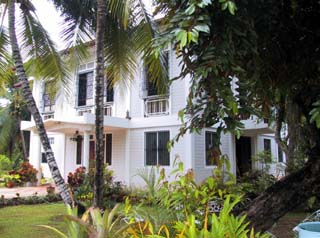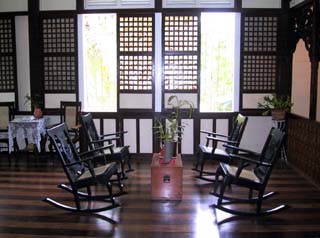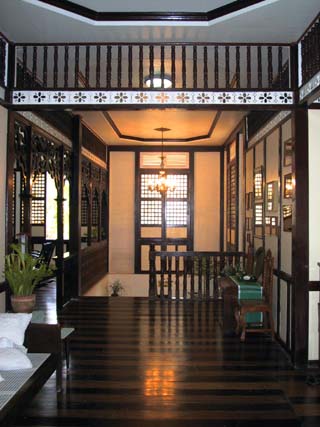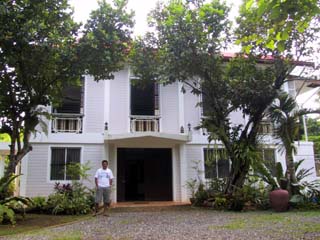Architecture in Bohol: The Heritage Beyond The Hills
Manila, Saturday, 6 May 2006

|
| The Man-Made Forest in Bilar. |
There is enough scenery on this small island to make your jaws drop and eyes melt many times over. The people are no less of a treasure, the Boholanos are welcoming, courteous, helpful, and honest. It is no wonder then why the islandís popularity has been booming. The resorts are crawling with tourists, mostly foreign and wholesome, with families or retirees making up the bulk of the vacationers. Good, clean, quiet fun is in abundant supply, one of the most popular daytime activities appears to be lying down in the sun and reading a book, although more strenuous activities such as hiking, diving, and dolphin-watching also have their enthusiasts. A party scene does exist, but itís not so in-your-face as elsewhere. There are a handful of hard-core backpackers hanging around, but most of the young people on the island originally came for more than just some R&R. On any given day you can meet German dental students on a medical outreach program (from whom one can learn that there are no Bavarian donuts in Bavaria), members of the US Peace Corps serving as school teachers (surprisingly game for in-depth discussions of Philippine society and politics), and young missionaries from Canada (very pious and very polite).

|
| The Cloribel Residence. |

|
| The Sala. |
The Cloribel house was built in 1926, and its structure was originally designed by a Spanish architect in the classic two-story bahay-na-bato style. The lower half of the house, called the zaguan, may have been used to store the family carriage in the old days. The main entry door is definitely large enough to admit a horse or automobile. The Cloribels currently utilize the space to stable their motorcycle, which is a favorite means of transportation among Boholanos. It now also serves as an informal receiving area.
The main living area is on the upper level. Large windows surround the second floor, taking advantage of the cool Panglao breezes. The window sashes still feature the original sliding panes of capiz and wood, ready to be shut tight during storms. Vents above the windows, protected by the roof eaves, let air in even when it's rainy. Small shuttered windows below the large windows, called ventanillas, are screened with grillwork and can be left open when the large windows are closed.

|
| The Sala Again. |

|
| The Entrance. |
Finding an authentic bahay-na-bato has become increasingly elusive, especially one that is still being kept alive by the original family's descendants. A lot of these ancestral houses are left to decay and be preyed upon by vandals and salvagers. The shared memory of the quintessential Filipino home, part of our national identity, is being worn away, torn down, or carted off to be sold for scrap. We must realize that protecting the legacy of the past is not a futile exercise in nostalgia, but a crucial task in defining our culture. The efforts of the Cloribel family and the province of Bohol show how Filipinos can live and progress in harmony with the land and its history. Sea and sand, hills and rivers, wood and stone, all these have come together in Bohol to build a place the entire country can be proud of.

|
| Front View. |
(Published in the Manila Bulletin in April 2004. Also appeared on the SkyscraperCity Forum on 30 April 2004. This forum has numerous articles on Philippine Architecture; republished here with permission from the author.)
Jude Defensor
What readers think...
| Rica Cloribel Reyes Cruz wrote: |
| Sunday, 13 November 2016 03:33:19 PHT |
| Dr. Fausto: My Tita Aida Cloribel and her husband, Sheldon, are currently visiting our home. She has a message for you. "Happy to get your message, Fausto! I was Aida Gallares then was widowed and now remarried to Sheldon Kirstein and now living in the U.S. I miss you too. You can contact my niece, Rica via Facebook (search for "Rica Cruz") and she will give you my address and contact information. Take care." |
| Dr. Fausto H. Loquias wrote: |
| Tuesday, 25 October 2016 16:13:14 PHT |
| The mansion of Atty. Cloribel in Mohon Panglao Bohol and one of her sibling is Proffesor Aida Cloribel my piano teacher in Holy Spirit School from grade 6 to 4rth high school nasaan nakaya siya ngayon miss you Maan Aida!!!! |
| Ibrahim taha wrote: |
| Wednesday, 19 December 2012 22:05:53 PHT |
| I like the inner designs. As well as the wood works. It's realy wounderful.... |
| Ibrahim taha wrote: |
| Wednesday, 19 December 2012 22:05:07 PHT |
| I like the inner designs. As well as the wood works. It's realy wounderful.... |
| JR Rodriguez IV wrote: |
| Sunday, 19 July 2009 14:42:40 PHT |
| Hey there Paulie, Marilen! Chamie, kamusta ka na? Paulie, let us know when you get back to the Philippines. I'm sure we'll be seeing you then. Do you have FaceBook? Guys, join me, search JR Rodriguez IV. I'm going to Bohol tomorrow, July 20th, until the 29th. Me and my wife will be photo covering the Sandugo festival this coming 26th. Maybe we should have a reunion when you come here, Paulie. E-mail me your contact details, let's try to do something next year. 8-) I have more Bohol pictures in my photo site: www.flickr.com/photos/jrrodrigueziv/ Best wishes to you all, JR Rodriguez IV. |
Read all 12 comments by readers.
Also give your comments on this article
We reserve the right to remove or edit comments posted on this website. Please read our conditions of use for details. You can use <i>italics</i>, <b>bold</b>, <p> new paragraph, <a href="url">link</a>. Other markup will be removed. Use of the forums for advertising is prohibited. Enterprises located in Bohol can request to be added to the business directory.





